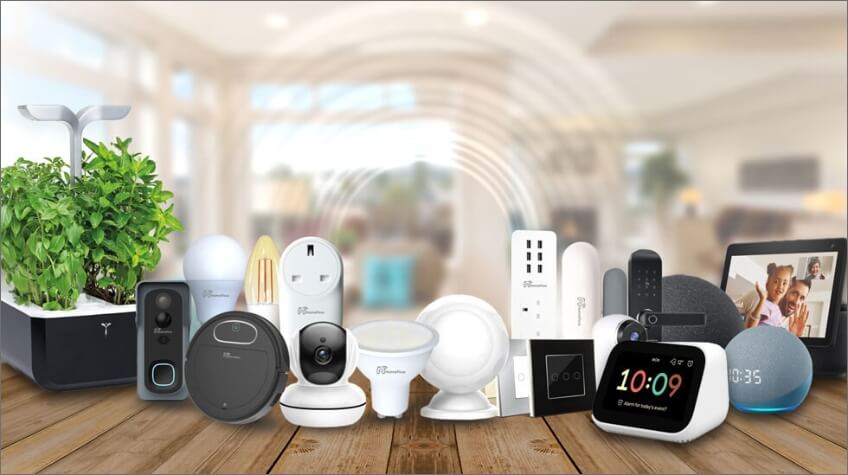Smart homes have become more accessible than ever thanks to innovations in connected technology. From security and lighting to energy management, these connected devices are transforming our daily lives, making our homes safer, more comfortable, and more energy-efficient. Here are 10 essential items for a high-performing smart home, designed to simplify and improve your life.

Voice assistants at the heart of the connected home
Voice assistants, such as Amazon Alexa, Google Assistant, or Apple’s Siri, are at the heart of many home automation systems. They allow users to control most connected devices via voice commands, schedule routines (like turning off all the lights at once), and even manage calendars. These assistants make smart homes easily accessible for the whole family.
Smart thermostats for optimal thermal comfort
A smart thermostat, like Google’s Nest or Tado, is an essential piece of home automation equipment. By analyzing your habits and weather conditions, it automatically adjusts the temperature for optimal comfort and reduced energy consumption. These thermostats can be controlled remotely via an app to avoid unnecessary heating when no one is home.
Connected security cameras real-time surveillance
Security is a key aspect of home automation, and connected security cameras, such as those from Nest, Ring, or Arlo, offer live monitoring from your smartphone. Some cameras are equipped with night vision, motion detection, and an instant alert option if suspicious movement is detected. They provide added peace of mind, whether you’re at home or away.
Smart locks for enhanced security
Smart locks, like those from Nuki or August, allow you to control access to your home without keys. You can lock or unlock the door from an app, and even create temporary access for guests or service providers. With a smart lock, there’s no need to hide keys under the doormat or worry about losing them.
Smart lighting for a customized atmosphere
Smart bulbs, like those from Philips Hue or Lifx, allow you to personalize the lighting in each room by adjusting the intensity and color. Using an app, you can program the lights to simulate occupancy when you’re away for an extended period, or to create a soothing atmosphere in the evening. These lights also help reduce energy consumption by allowing you to turn them off remotely.
Smart plugs remote device management
Smart plugs, like those from TP-Link or Eve Energy, allow you to remotely control any device plugged into them, from coffee makers to fans. They can be programmed to automatically switch off at night or during off-peak hours, which is ideal for avoiding unnecessary energy consumption. These smart plugs are particularly useful for non-connected devices, making them more flexible and energy-efficient.
Connected smoke, monoxide, and carbon detectors enhanced safety
Connected smoke and carbon monoxide detectors, such as the Nest Protect, are essential for safety. They send alerts directly to your smartphone in case of danger, even when you’re away. Some detectors can also alert local authorities or trigger a built-in alarm to ensure a rapid response in the event of a fire or gas leak.
Robot vacuum cleaners for effortless cleaning
Robot vacuums, like the iRobot Roomba or Roborock models, handle daily cleaning completely autonomously. Programmable via an app, these devices can map your home, avoid obstacles, and even empty themselves automatically on some advanced models. They allow you to keep your home clean effortlessly, especially for large houses or households with pets.
Smart sprinklers for a well-maintained garden
Smart sprinklers, like the Rachio system, allow you to manage your garden’s watering intelligently. They adjust the watering frequency according to weather forecasts and the seasons.
This helps reduce water consumption and keep your plants healthy. Ideal for gardening enthusiasts, these smart sprinklers make garden maintenance easier and waste-free.
Smart refrigerators for simplified grocery shopping
Smart refrigerators, like those from LG or Samsung, simplify food management. Equipped with internal cameras, they allow you to check the contents of your fridge from your smartphone to avoid unnecessary purchases. Some models also offer recipes based on the ingredients you have on hand and send alerts when food items are nearing their expiration date.
Why adopt these devices for a smart home?
By integrating these connected devices, a home becomes safer, more energy-efficient, and more comfortable. These home automation devices allow you to:
- Save time: By automating tasks, you reduce the time spent on chores.
- Save money: by optimizing energy and water consumption, you reduce bills.
- Enhance security: connected cameras, locks, and smoke detectors allow you to monitor your home and react quickly in case of a problem.
- Enhance comfor : managing temperature, lights, and audio creates a pleasant and personalized atmosphere.
Smart home technology is no longer a futuristic trend, but an accessible and practical reality. With lower costs and improved compatibility between devices, it’s easier than ever to transform your house into a connected home that simplifies everyday life.
Smart homes: the future of housing
Home automation continues to evolve to meet the needs of modern users in terms of security, comfort, and energy efficiency. By integrating these 10 essential devices, you can not only improve your quality of life but also contribute to better energy and resource management. Whether you’re new to smart homes or already a home automation enthusiast, these devices are investments that will change your daily life for the better.
